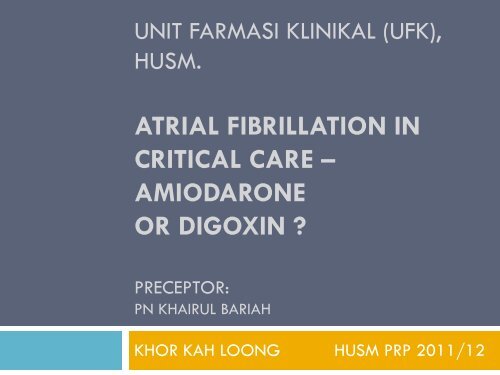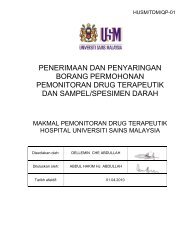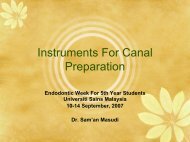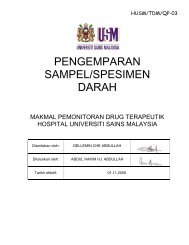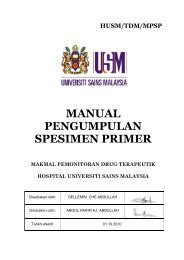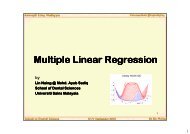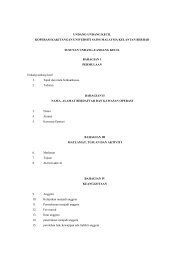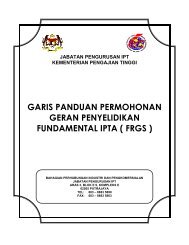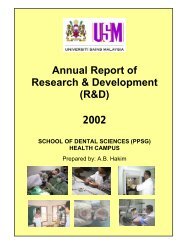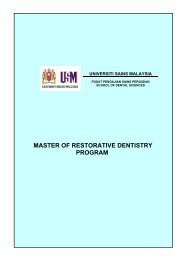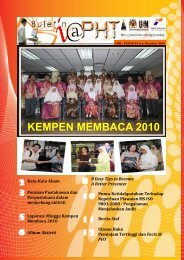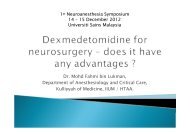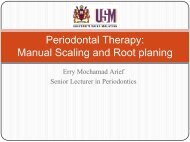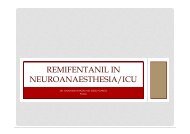AMIODARONE OR DIGOXIN
AMIODARONE OR DIGOXIN
AMIODARONE OR DIGOXIN
Create successful ePaper yourself
Turn your PDF publications into a flip-book with our unique Google optimized e-Paper software.
UNIT FARMASI KLINIKAL (UFK),<br />
HUSM.<br />
ATRIAL FIBRILLATION IN<br />
CRITICAL CARE –<br />
<strong>AMIODARONE</strong><br />
<strong>OR</strong> <strong>DIGOXIN</strong> ?<br />
PRECEPT<strong>OR</strong>:<br />
PN KHAIRUL BARIAH<br />
KH<strong>OR</strong> KAH LOONG HUSM PRP 2011/12
Presentation Outline<br />
Objectives<br />
Introduction<br />
Discussion<br />
Conclusion<br />
Reference
OBJECTIVES
OBJECTIVES<br />
To present on management of atrial fibrillation in<br />
critical care<br />
To discuss on the comparison between Digoxin and<br />
Amiodarone in management of acute atrial<br />
fibrillation.
INTRODUCTION<br />
DEFINTION<br />
CLASSIFICATION<br />
MANAGEMENT
DEFINITION 1,2<br />
Supraventricular tachyarrhythmia<br />
Uncoordinated atrial activation<br />
Atrial<br />
Rapid<br />
Irregular<br />
Chaotic<br />
Deterioration in atrial mechanical function<br />
Irregular-rapid ventricular response<br />
Irregularly-irregular
CLASSIFICATION 1 (1)<br />
First Detected<br />
(One-Diagnosed Episode)<br />
Paroxymal<br />
(< 7days)<br />
Persistent<br />
(> 7days)<br />
Permanent<br />
(>1 year)
CLASSIFICATION 1 (2)<br />
Lone AF<br />
No clinical or echocardiographic evidence of<br />
cardiopulmonary disease (including HPT)<br />
Young patient (
CLASSIFICATION 2,3 (3)<br />
CLASS ACTIONS DRUGS CAUTIONS<br />
IA<br />
IB<br />
IC<br />
Na + channel inhibition:<br />
prolong repolarization<br />
Na + channel inhibition:<br />
shorten repolarization<br />
Na + channel inhibition: no<br />
effect on repolarization but<br />
reduce conductivity<br />
Quinidine, procainamide,<br />
disopyramide<br />
Lidocaine<br />
Flecainide, propafenone<br />
II β-Adrenergic inhibition Timolol, esmolol, atenolol,<br />
bisoprolol<br />
III<br />
K + channel inhibition: prolong<br />
repolarization<br />
Vaughan-Williams Classification<br />
Amiodarone, sotalol*<br />
History of myocardial infarction,<br />
congestive heart failure, renal<br />
disease<br />
Proarrhythmias<br />
Structural heart disease, history of<br />
myocardial infarction, congestive<br />
heart failure<br />
Acute heart failure, bronchospasm<br />
Renal disease, pulmonary disease<br />
IV Ca 2+ channel inhibition Verapamil, diltiazem Not in conjunction with β-blockers<br />
Misc<br />
Na-K ATPase inhibition:<br />
parasympathetic response<br />
Digoxin<br />
Renal disease, hypokalemia
CLASSIFICATION (4)<br />
Critical Care ?<br />
Acute Atrial Fibrillation<br />
Onset < 48 h<br />
Includes:<br />
• Paroxysmal AF<br />
• First symptomatic presentation of Persistent AF
MANAGEMENT 1,2 (1)<br />
3 Objectives:<br />
Rate control<br />
Prevention of Thromboembolism<br />
Correction of the rhythm disturbance<br />
Rate control ? Rhythm control ?
RHYTHM CONTROL 1<br />
Conversion to NSR either by electrical (DCC) or<br />
pharmacological (AAD) cardioversion.<br />
Haemodynamically unstable: Electrical<br />
Haemodynamically stable: Either<br />
Electrical conversion<br />
Preferred: greater efficacy (85% vs 45%) and low<br />
proarrhythmic risk.<br />
But required generalized anaethesia
RATE CONTROL 1<br />
Slowing AV conduction<br />
Slow ventricular response rate → better<br />
ventricular filling with blood.<br />
If intolerable to S/E of rate-control agent<br />
Combining lower-dose digoxin + B-blockers/CCBs<br />
Amiodarone effective for patient who are not<br />
cardioverted to NSR.<br />
Good control:<br />
Rest: 60-80 bpm,<br />
Moderate: 90-115 bpm
MANAGEMENT 2 (2)
MANAGEMENT 2 (3)<br />
Haemodynamically Instability<br />
Ventricular rates > 150<br />
Ongoing chest pain<br />
Evidence of critical perfusion<br />
• Systolic BP < 90 mm Hg<br />
• Heart failure<br />
• Reduced consciousness<br />
To anticoagulate prior conversion if high risk<br />
Heparin
MANAGEMENT 2 (4)
MANAGEMENT 2 (5)
MANAGEMENT 1,2 (6)<br />
Focus:<br />
Symptom relief<br />
Prevention of complications<br />
Pharmacotherapy<br />
Rate Control<br />
• Class II, Class IV, Digoxin<br />
Rhythm Control<br />
• Class I, Class III, Amiodarone<br />
Anticoagulation
MANAGEMENT 2 (7)
RATE CONTROL AGENT 1<br />
Drug<br />
Esmolol<br />
(II)<br />
Metoprolol<br />
(II)<br />
Propranolol<br />
(II)<br />
Diltiazem<br />
(IV)<br />
Verapamil<br />
(IV)<br />
Recommendation<br />
/ LOE<br />
I / C<br />
I / C<br />
LD Onset MD Major S/E<br />
500 mcg/kg IV<br />
over 1 min<br />
2.5 to 5 mg IV<br />
bolus over 2 min;<br />
up to 3 doses<br />
5 mins 60 to 200<br />
mcg/kg/min IV<br />
↓BP, HB, ↓HR,<br />
asthma, HF<br />
5 mins - ↓BP, HB, ↓HR,<br />
asthma, HF<br />
I / C 0.15 mg/kg IV 5 mins - ↓BP, HB, ↓HR,<br />
asthma, HF<br />
I / B<br />
Rate Control (No accessory pathway)<br />
0.25 mg/kg IV<br />
over 2 min<br />
I / B 0.075 to 0.15<br />
mg/kg IV over 2<br />
min<br />
2-7<br />
mins<br />
3-5<br />
mins<br />
5 to 15 mg/h<br />
IVI<br />
↓BP, HB, HF<br />
- ↓BP, HB, HF
Drug<br />
Digoxin<br />
(Misc)<br />
RATE CONTROL AGENT 1<br />
Rate Control in HEART FAILURE (No accessory pathway)<br />
Recommendation<br />
/ LOE<br />
I / B<br />
LD Onset MD Major S/E<br />
0.25 mg<br />
IV each 2<br />
h, up to<br />
1.5 mg<br />
Amiodarone IIa / C 150 mg<br />
over 10<br />
min<br />
60<br />
mins or<br />
more<br />
0.125 to<br />
0.375 mg<br />
daily IV<br />
or orally<br />
Days 0.5 to 1<br />
mg/min IV<br />
Digitalis toxicity, HB, ↓HR<br />
↓BP, HB, pulmonary toxicity,<br />
skin discoloration,<br />
hypothyroidism,<br />
hyperthyroidism, corneal<br />
deposits, optic neuropathy,<br />
warfarin interaction, sinus<br />
bradycardia
Drug<br />
RATE CONTROL AGENT 1<br />
Recommendation<br />
/ LOE<br />
Amiodarone IIa / C 150 mg<br />
over 10<br />
min<br />
Rate Control (With accessory pathway)<br />
LD Onset MD Major S/E<br />
Days 0.5 to 1<br />
mg/min<br />
IV<br />
↓BP, HB, pulmonary toxicity, skin<br />
discoloration, hypothyroidism,<br />
hyperthyroidism, corneal deposits,<br />
optic neuropathy, warfarin<br />
interaction, sinus bradycardia<br />
*Intravenous administration of drugs such as digitalis, verapamil, or diltiazem, which<br />
lengthen refractoriness and slow conduction across the AV node, does not block conduction<br />
over the accessory pathway and may accelerate the ventricular rate. Hence<br />
CONTRAINDICATED in AF with accessory pathway. Caution in B-Blockers*
RHYTHM CONTROL AGENT 1,2<br />
Drug Recomm’ /<br />
LOE<br />
Flecainide<br />
(Ic)<br />
Propafenone<br />
(Ic)<br />
Amiodarone<br />
(III)<br />
Sotalol<br />
(III)<br />
Conversion Dose Onset MD Comments<br />
I / A IV 2mg/kg <strong>OR</strong> 200<br />
mg orally, repeat<br />
after 3–4 h<br />
I / A IV 2mg/kg <strong>OR</strong> 600<br />
mg orally<br />
IIa / A<br />
Not recomm’<br />
COMMON PHARMACOLOGIC Rhythm Conversion<br />
6 mg/kg bolus over<br />
30–60 min, then<br />
1,200 mg IV over 24<br />
h<br />
5–10 mg slowly IV,<br />
may be repeated<br />
50–150 mg<br />
bid<br />
150–300 mg<br />
bid<br />
600 mg/d x<br />
1/52, follow<br />
by 400 mg/d<br />
x 1/52, then<br />
200 mg daily<br />
120–160 mg<br />
bid<br />
Only for without<br />
structural heart<br />
disease<br />
Only for without<br />
structural heart<br />
disease<br />
Moderately<br />
effective, slow<br />
onset, good HR<br />
control;<br />
hypotension<br />
(bolus dose)<br />
Slow Conversion<br />
rate; High<br />
proarrhythmia
SR MAINTAINENCE AGENT 1
MANAGEMENT 2 (8)<br />
HEPARIN<br />
LMWH<br />
HEPARIN-<br />
WARFARIN
MANAGEMENT 1 (9)<br />
Anticoagulation<br />
In emergency electric conversion (48h):<br />
LD Heparin followed by continuous infusion to keep 1.5-<br />
2 x control.<br />
Follow by warfarin for at least 3-4weeks to maintain<br />
INR of 2-3.<br />
In elective conversion:<br />
For AF >48hr & haemodynamically stable,<br />
anticoagulate for at least 3-4 weeks before & after<br />
conversion<br />
Transoesophageal echocardiography (TEE)<br />
performed prior to exclude left atrial appendage<br />
clot (↑risk of stroke).
DISCUSSION<br />
<strong>AMIODARONE</strong> <strong>OR</strong> <strong>DIGOXIN</strong> ?
<strong>AMIODARONE</strong> 3 (1)<br />
Benzofuran derivative<br />
Class III AAD<br />
IV / Oral<br />
MOA<br />
Potassium channel inhibition<br />
• Prolongation of the myocardial cell-action potential duration<br />
and refractory period<br />
• All cardiac tissues<br />
Noncompetitive α- and β-adrenergic inhibition
<strong>AMIODARONE</strong> (2)<br />
Study<br />
Peuhkurinen<br />
4<br />
et al<br />
Year Design AF<br />
Onset<br />
2000 RCT,<br />
p=62<br />
Comparison/Subject Result / Conclusion<br />
<strong>AMIODARONE</strong> (3)<br />
Study<br />
Chevaliar 7<br />
et al<br />
Year Design AF<br />
Onset<br />
2003 Metaanalysis<br />
13 RCT<br />
Comparison/Subject Result / Conclusion<br />
- 1. Amiodarone vs<br />
Placebo<br />
2. Amiodarone vs<br />
Class Ic AAD<br />
1) 24h = RR 1.44, p
<strong>DIGOXIN</strong> 8 (1)<br />
Digitalis glycosides<br />
Indications:<br />
Atrial Fibrillation<br />
• Ventricular rate control<br />
Heart Failure<br />
MOA<br />
• LV Ejection Fraction<br />
• Improve symptoms, reduced hospitalisation<br />
Na-K ATPase inhibitor<br />
Vagomimetic effect – HR & AV conduction<br />
Sympathetic activity – baroreceptor sensitization
<strong>DIGOXIN</strong> (2)<br />
Study Year Design AF<br />
Onset<br />
Falk 9 et al<br />
Jordaens 10<br />
et al<br />
1987 RCT<br />
p=36<br />
1997 DB-RCT<br />
p=40<br />
Comparison/<br />
Subject<br />
<strong>AMIODARONE</strong> VS <strong>DIGOXIN</strong> (1)<br />
Study<br />
Year Design AF<br />
Onset<br />
Hou 12 et al 1995 R-<br />
control<br />
study<br />
p=50<br />
Comparison/<br />
Subject<br />
<strong>AMIODARONE</strong> VS <strong>DIGOXIN</strong> (2)<br />
Study Year Design AF<br />
Onset<br />
Joseph 1<br />
3<br />
et al<br />
2000 Prospective<br />
RCT,<br />
p=120<br />
Comparison/<br />
Subject<br />
<strong>AMIODARONE</strong> VS <strong>DIGOXIN</strong> (3)<br />
Study Year Design AF<br />
Onset<br />
Thomas<br />
14<br />
et al<br />
2004 R-Digoxin<br />
controlled<br />
trial.<br />
p=140<br />
Comparison/<br />
Subject<br />
- Amiodarone<br />
(10mg/kg in<br />
30mins)<br />
or<br />
Sotalol<br />
(1.5mg/kg in<br />
10mins)<br />
vs<br />
Digoxin<br />
(500ug in<br />
20mins)<br />
(placebo)<br />
Result / Conclusion<br />
Similar rates of pharmocological conversion to<br />
sinus rhythm<br />
51% vs 44% vs 50%, p=not significant<br />
“The overall rates of cardioversion after trial<br />
drug infusion and defibrillation were high for all<br />
groups (amiodarone, 94%; sotalol, 95%,;<br />
digoxin, 98%; P = not significant), but there was<br />
a trend toward a higher incidence of serious<br />
adverse reactions in the amiodarone group.”
<strong>AMIODARONE</strong> VS <strong>DIGOXIN</strong> (4)<br />
Study Year Design AF<br />
Onset<br />
Hofmann<br />
15<br />
et al<br />
2006 R-Digoxin<br />
controlled<br />
trial.<br />
p=140<br />
Comparison/<br />
Subject<br />
- IV bolus<br />
amiodarone<br />
vs IV bolus<br />
digoxin<br />
Result / Conclusion<br />
Baseline HR = 144 ± 19 vs 145 ± 15<br />
30mins = 104 ± 25 vs 116 ± 23 (p=0.02)<br />
60mins = 94 ± 22 vs 105 ± 22 (p=0.03)<br />
Better HR reduction<br />
SR conversion:<br />
30mins = 28% vs 6% (p=0.003)<br />
60mins = 42% vs 18% (p=0.012)<br />
Amiodarone S/E:<br />
Asymptomatic hypotension (p=4), Superficial<br />
phlebitis (p=1)<br />
“Amiodarone, given as an intravenous bolus is<br />
relatively safe and more effective than<br />
digoxin for heart rate control and conversion<br />
to sinus rhythm in patients with atrial<br />
fibrillation and a rapid ventricular rate.”
CONCLUSION
CONCLUSION<br />
Based on current evidence, amiodarone appears to<br />
be more effective and fast in terms of SR<br />
restoration in comparison with digoxin.<br />
Important in critical care setting<br />
Digoxin is not recommended for SR conversion<br />
Amiodarone also effective in rate control when<br />
other agent fails or contraindicated.<br />
However, amiodarone associated with various<br />
adverse effect<br />
Close monitoring and precaution is needed
REFERENCES
REFERENCES<br />
1. Fuster V, Rydén LE, Cannom DS, Crijns HJ, Curtis AB, Ellenbogen KA, et al. 2011 ACCF/AHA/HRS Focused Updates Incorporated Into the ACC/AHA/ESC 2006 Guidelines for the<br />
Management of Patients With Atrial Fibrillation: A Report of the American College of Cardiology Foundation/American Heart Association Task Force on Practice Guidelines Developed in<br />
partnership with the European Society of Cardiology and in collaboration with the European Heart Rhythm Association and the Heart Rhythm Society. Journal of the American College of<br />
Cardiology.57(11):e101-e98.<br />
2. Khoo CW, Lip GYH. Acute management of atrial fibrillation. Chest 2009;135:849-59<br />
3. Rxlist. Cordarone. [online] 2011 [cited on 2012 Feb 27]; Available from: URL:http://www.rxlist.com/cordarone-drug.htm<br />
4. Peuhkurinen K, Niemela M, Ylitalo A, et al. Effectiveness of amiodarone as a single oral dose for recent-onset atrial fibrillation. Am J Cardiol 2000;85:462–5.<br />
5. Faniel R, Schoenfeld P. Efficacy of IV amiodarone in converting rapid atrial fibrillation and flutter to sinus rhythm in intensive care patients. Eur Heart J 1983;4:180–5<br />
6. Hilleman DE, Spinler SA. Conversion of recent-onset atrial fibrillation with intravenous amiodarone: a meta-analysis of randomized controlled trials. Pharmacotherapy 2002;22:66–74.<br />
7. Chevalier P, Durand-Dubief A, Burri H, et al. Amiodarone versus placebo and classic drugs for cardioversion of recent-onset atrial fibrillation: a meta-analysis J Am Coll Cardiol, 2003;41:255–<br />
62.<br />
8. Rxlist. Lanoxin injection. [online] 2011 [cited on 2012 Feb 27]; Available from: URL: http://www.rxlist.com/lanoxin-drug/clinical-pharmacology.htm<br />
9. Falk RH, Knowlton AA, Bernard SA, et al. Digoxin for converting recent-onset atrial fibrillation to sinus rhythm: a randomized, double-blinded trial. Ann Intern Med 1987;106:503–6.<br />
10. Jordaens L, Trouerbach J, Calle P, et al. Conversion of atrial fibrillation to sinus rhythm and rate control by digoxin in comparison to placebo. Eur Heart J 1997;18:643–8.<br />
11. Digitalis in Acute AF (DAAF) Trial Group. Intravenous digoxin in acute atrial fibrillation: results of a randomized, placebo-controlled multicentre trial in 239 patients; The Digitalis in Acute Atrial<br />
Fibrillation (DAAF) Trial Group. Eur Heart J 1997;18:649–54.<br />
12. Hou ZY, Chang MS, Chen CY, et al. Acute treatment of recent-onset atrial fibrillation and flutter with a tailored dosing regimen of intravenous amiodarone. A randomized, digoxin-controlled<br />
study. Eur Heart J 1995;16:521–8.<br />
13. Joseph AP, Ward MR. A prospective, randomized controlled trial comparing the efficacy and safety of sotalol, amiodarone, and digoxin for the reversion of new-onset atrial fibrillation. Ann<br />
Emerg Med 2000;36:1–9<br />
14. Thomas SP, Guy D, Wallace E, et al. Rapid loading of sotalol or amiodarone for management of recent onset symptomatic atrial fibrillation: a randomized, digoxin-controlled trial. Am Heart J<br />
2004;147:E3<br />
15. Hofmann R, Steinwender C, Kammler J, et al. Effects of a high dose intravenous bolus amiodarone in patients with atrial fibrillation and a rapid ventricular rate. Int J Cardiol 2006;110:27–32


